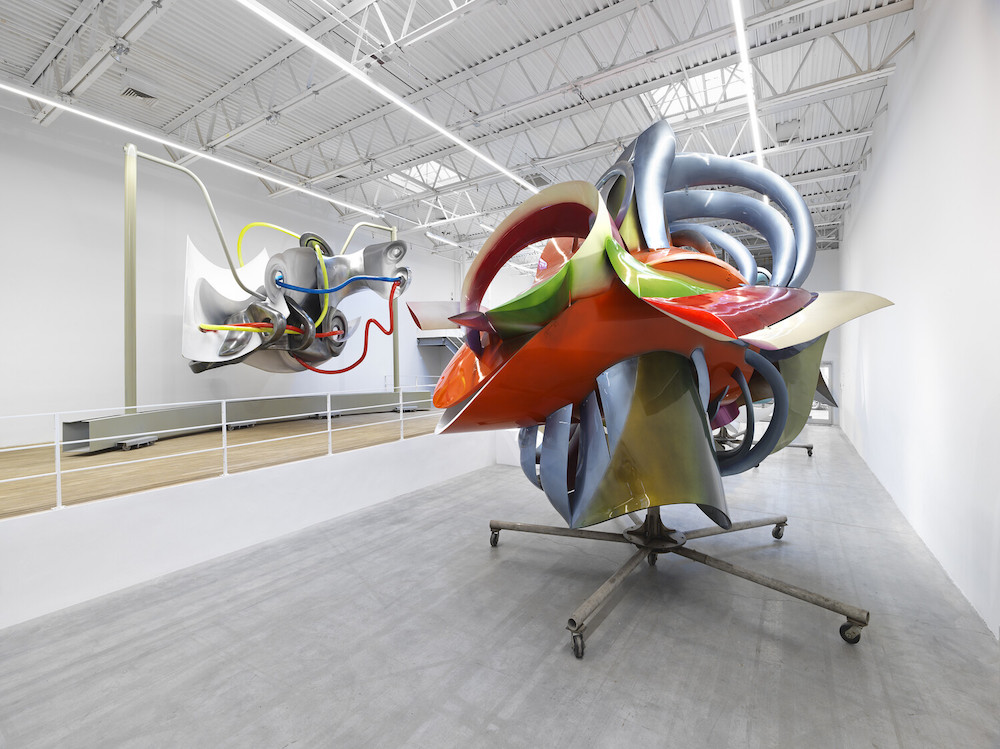Have you ever started a journey, traveling a great distance through countless notable destinations, only to decide one day to completely reverse course? This column started out as many do, a haphazard scroll through Instagram looking at art, upcoming exhibitions, various galleries and the digital intersection of it all. A ubiquitous ad for Jeffrey Deitch caught my eye, reminding me of the newer works of Frank Stella. For an artist that has efficaciously existed for over 60 years in the art world—newer is slightly relative. These were not minimalist paintings that many in a contemporary art canon course may link with his name, but rather grandiose objects that merge geometric lines and undulating planes in a way that can easily be described as something seen in a Mad Hatter fever dream. All things move and connect as does an Escher staircase, visually confirming but at the same time sexily defying physics. I had never been able to explore these works at length but, considering the central role that both the digital process and 3D printing played in the manifestation of these sculptures—I was excited to be heading down the rabbit hole of exploring this historic artist’s newest chapter.
Knowing Stella’s status as arguably the godfather of minimalist painting, I was somewhat less interested in a critique of the sculptures or how they may or may not tie to his paintings, but rather more to explore a tale of reinvention—a story of artistic rebirth while aging, as both technology and our interests change. The seed was set for what my critical curiosities desired. The timing was perfect—with Stella’s May show at Jeffrey Deitch in New York—for his most ambitious sculptural works to date. Little did I know that I would be finishing writing this after Stella’s death, about someone being bold enough to embody a new method of creation in the final years of an epic run in the art world. I had not anticipated this awkward version of an obituary.

“Frank Stella: Recent Sculpture.” Installation photos: Genevieve Hanson.
© 2024 Frank Stella / Artists Rights Society (ARS).
So, this column will not be that (an obituary), but rather a discourse centered around transitions, about how we align ourselves as new technologies grow and force themselves to the forefront. With these new tools, how and why do those who have been gaining acclaim doing the same thing for countless years decide to take a hard right turn and head down a completely different path? But isn’t this at the core of what being an artist is? Swimming against the current, painting straight lines and circles when it is unfashionable, moving on to the next realm when those same lines are now fashionable/inconsequentially accepted. It is well-documented that Stella made sculptural objects for more than two decades, but with his use of the computer as a 3D painterly tool, the objects continued to evolve. The evolution of 3D printing has contributed significantly to Stella’s work, primarily used for maquette production. Most notably in 2022, when Stella released his first NFT for his “Geometries”—which included 22 new works spread over 2100 tokens—each blockchain artwork included the digital model to 3D print the sculpture shown on the NFT.
Some may argue that the magical embodiment of artistic creation lies in the manifestation of new ideas forming around what we can do as our surroundings and circumstances change. Some old dogs can’t be taught new tricks; with others it just takes time to catch up, to integrate new technology with their tremendous vision. I see both sides of the coin, or better yet, token. But why eat stale bread when a beautiful new bakery has just opened next door?


